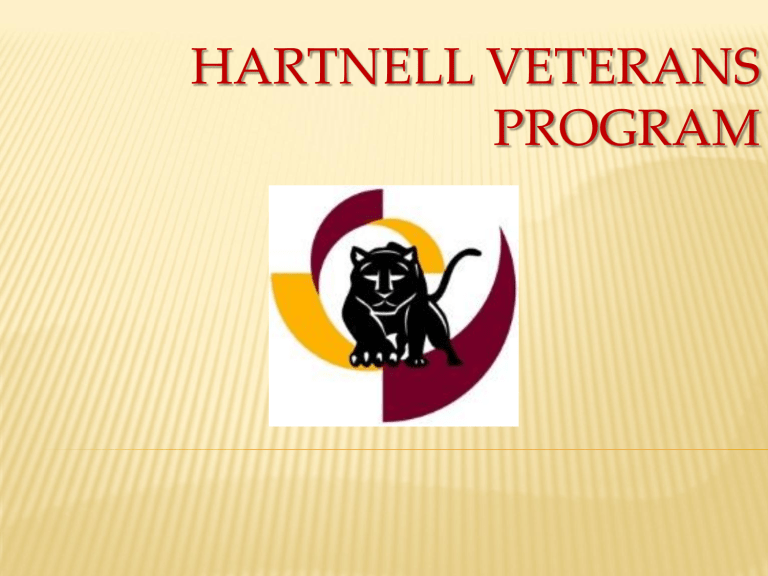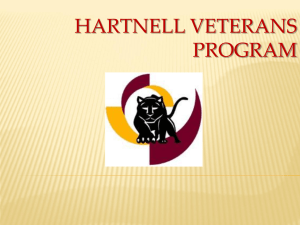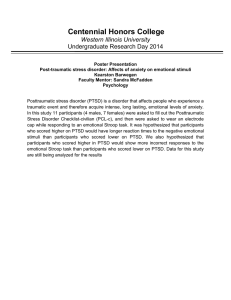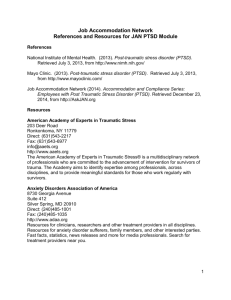HARTNELL VETERANS PROGRAM

HARTNELL VETERANS
PROGRAM
AGENDA
Program information
Overview of PTSD
Cluster of symptoms
What PTSD looks like
Treatment
Visuals
PROGRAM STAFF
Maria Schlotthauer, Program Analyst
II/Certifying Official
Gemma Uribe-Cruz, Program Counselor
We have 5 VA work study students
WHAT WE OFFER
Certification Services
Educational Counseling
A place where they can gather
Support groups
Family support
Employment Referral Services
Help filing for VA Benefits
Coordinate Education Referral Services
Social Events
OUR NUMBERS
Currently have 108 certified students
Serving 41 un-certified students
9 fall grads
3 of 9 will be transferring
17 spring grads
13 of 17 will be transferring
POST TRAUMATIC STRESS DISORDER (PTSD)
•
•
•
•
•
Post Traumatic Stress Disorder is an anxiety disorder that can occur following the experience or after witnessing a traumatic event.
Combat
Childhood Abuse or Rape
Accidents
Assault
Disasters
PTSD CONTINUED
PTSD is diagnosed when symptoms last up to 4 weeks or longer
Many people with PTSD naturally get better over time. But for some, PTSD is a chronic condition and does not improve over time.
Failure of recovery
POST TRAUMATIC STRESS DISORDER (PTSD)
The person experiences a traumatic event involving threat to life and a response of horror, helplessness and intense fear.
Re-experiencing Symptoms
Avoidance Symptoms
Hyper-arousal Symptoms
CLUSTERS OF SYMPTOMS
Reliving – think about trauma when you don’t want to. Uninvited thoughts. Nightmares.
Flashbacks.
Avoiding – avoid situations or people that remind of events, avoid talking or thinking about trauma, avoid situations that trigger fight or flight alarm response, spend most of time alone to avoid being triggered
CLUSTERS OF SYMPTOMS
Hyperarousal – feel jittery or stressed, constantly on alert, uncomfortable with strangers, angry or irritable, trouble sleeping, difficulty concentrating, easily startled by unexpected noises.
WHAT PTSD MAY LOOK LIKE IN EVERYDAY
LIFE:
Social Anxiety
Difficulty in relationships
Needing to sit in the back, corner
Difficulty with others crowding or being behind them
May feel out of place or alienated
Tendency to isolate
Difficulty regulating emotions – topics that trigger
(Lack of affect or extreme emotions)
Altered Views about the world, self, and people
WHAT PTSD MAY LOOK LIKE EVERYDAY LIFE:
Low Tolerance for:
Others not following directions (Group work)
Lack of gratitude
Lack of structure
Carelessness
Loud noises
Difficulty concentrating
Low self-esteem
Memory Impairment
TREATMENTS
Cognitive Behavioral Treatments
Medication
WHAT YOU CAN DO:
•
•
•
•
• Listen actively
Encourage the veteran to tell you more
Indicate understanding
Non-judgmental
Make referrals to our Veterans
Program
http://www.halfofus.com/video/anxietydisorders/
https://www.youtube.com/watch?v=2qFifJc06vA
DISCUSSION…
QUESTIONS?
REFERENCES
Vet Center Keeping The Promise . (n.d.). [Pamphlet
“Presentations help staff gain access” Houston Crum,
A.C.S.W., Vet Center Voice
“Planning session defines agency roles” David Collier,
Psy.D., Vet Center Voice
“Iraq War Clinicians Guide, 2 nd ” National Center for PTSD,
DVA
DSM – IV – TR (Diagnostic and Statistical Manual)




